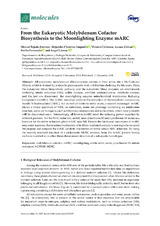From the Eukaryotic Molybdenum Cofactor Biosynthesis to the Moonlighting Enzyme mARC
Autor
Tejada Jiménez, M.
Chamizo-Ampudia, Alejandro
Calatrava, Victoria
Galván Cejudo, Aurora
Fernández Reyes, Emilio
Llamas Azúa, Ángel
Editor
MDPIFecha
2018Materia
Molybdenum cofactormARC
Moonlighting
Nitrite
Nitric oxide
Cytochrome b5
Nitrate reductase
NOFNiR
MOSC
METS:
Mostrar el registro METSPREMIS:
Mostrar el registro PREMISMetadatos
Mostrar el registro completo del ítemResumen
All eukaryotic molybdenum (Mo) enzymes contain in their active site a Mo Cofactor (Moco), which is formed by a tricyclic pyranopterin with a dithiolene chelating the Mo atom. Here, the eukaryotic Moco biosynthetic pathway and the eukaryotic Moco enzymes are overviewed, including nitrate reductase (NR), sulfite oxidase, xanthine oxidoreductase, aldehyde oxidase, and the last one discovered, the moonlighting enzyme mitochondrial Amidoxime Reducing Component (mARC). The mARC enzymes catalyze the reduction of hydroxylated compounds, mostly N-hydroxylated (NHC), but as well of nitrite to nitric oxide, a second messenger. mARC shows a broad spectrum of NHC as substrates, some are prodrugs containing an amidoxime structure, some are mutagens, such as 6-hydroxylaminepurine and some others, which most probably will be discovered soon. Interestingly, all known mARC need the reducing power supplied by different partners. For the NHC reduction, mARC uses cytochrome b5 and cytochrome b5 reductase, however for the nitrite reduction, plant mARC uses NR. Despite the functional importance of mARC enzymatic reactions, the structural mechanism of its Moco-mediated catalysis is starting to be revealed. We propose and compare the mARC catalytic mechanism of nitrite versus NHC reduction. By using the recently resolved structure of a prokaryotic MOSC enzyme, from the mARC protein family, we have modeled an in silico three-dimensional structure of a eukaryotic homologue.

